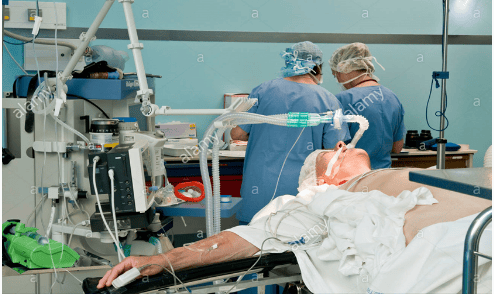This is an automatically translated article.
The article was professionally consulted by Specialist Doctor I Tran Thi Ngat - Department of General Surgery - Vinmec Da Nang International General Hospital.1. What is laparoscopic anesthesia?
Laparoscopic surgery is a technique for minimally invasive intra-abdominal surgery. The advantages of laparoscopy compared to laparotomy are reduced surgical trauma, less pain, less post-operative cardiopulmonary complications and shorter recovery time.However, for laparoscopic surgery to have a high probability of success, the role of anesthesia plays a large part. Laparoscopic anesthesia will improve unintentional trauma to other organs in the abdomen, reducing the risk of mechanical trauma during surgery for the patient.
However, laparoscopic anesthesia can also cause physiological changes, especially in the circulatory and respiratory systems in the elderly, increasing the perioperative risk for the patient.

2. Conditions for performing laparoscopic anesthesia
In order for the anesthesia for laparoscopic surgery to be effective, the operating room must be fully equipped with facilities and comply with safety regulations. Moreover, the patient was also carefully prepared for surgery, the lying position is suitable for each type of endoscopy.To protect the airway as well as reduce gastrointestinal pressure during surgery, the patient needs to place and save a nasogastric tube during surgery. This will have the benefit of significantly reducing intra-abdominal volume, increasing the surgical field, and making it easier for the technician to manipulate.
3. How is laparoscopic anesthesia performed?
Before performing laparoscopic anesthesia, the operating room must ensure that it is fully equipped with facilities and machines to help monitor the patient, including: Electrocardiogram, non-invasive blood pressure monitoring , measuring oxygen concentration in peripheral capillaries, electrocardiogram and monitoring temperature.In the next step, the patient is given general anesthesia for laparoscopic surgery with anesthesia, analgesics, muscle relaxants and intubation or laryngeal mask, followed by a ventilator. During the surgery, the patient was maintained under deep anesthesia depending on the length of surgery. If laparoscopic surgery is performed on an outpatient basis, the anesthetic agents of choice are the short-acting drugs that help the patient wake up quickly.

4. What to monitor after laparoscopic anesthesia
Patients must be adequately monitored and managed if there are abnormalities in vital functions including peripheral oxygen saturation, respiratory rate, electrocardiogram, blood pressure and heart rate measurements, temperature, and blood pressure monitoring. control pain and surgical complications such as bleeding. The outstanding problems after laparoscopic surgery are as follows:4.1 Nausea and vomiting after surgery Vomiting and nausea after laparoscopic surgery is a common complication that causes discomfort and greatly affects the health of patients. patient. Anesthesiologists will assess the level and have treatment and prevention plans according to standard protocols.

In summary, laparoscopic surgery today has been widely applied due to its outstanding advantages compared to open laparotomy. However, regardless of the modality, the role of anesthesia still plays a decisive part. Accordingly, laparoscopic anesthesia needs to follow the correct procedure, comply with safety regulations in the condition of adequate facilities and human resources, which will contribute to the success of the surgery.
Dr. Ngat has more than 15 years of experience as an Anesthesiologist and resuscitator at Hospitals: Da Nang Obstetrics and Gynecology Hospital, Hospital 199 Ministry of Public Security, Tam Tri Hospital Da Nang. Currently, he is an anesthesiologist at the Department of General Surgery - Vinmec Danang International General Hospital.
Please dial HOTLINE for more information or register for an appointment HERE. Download MyVinmec app to make appointments faster and to manage your bookings easily.
SEE MORE
Diagnosis and Laparoscopic Surgery How does laparoscopy take place? In what cases is laparoscopic surgery usually indicated?














